stop start Hyundai Equus 2011 Owner's Manual
[x] Cancel search | Manufacturer: HYUNDAI, Model Year: 2011, Model line: Equus, Model: Hyundai Equus 2011Pages: 385, PDF Size: 10.67 MB
Page 11 of 385
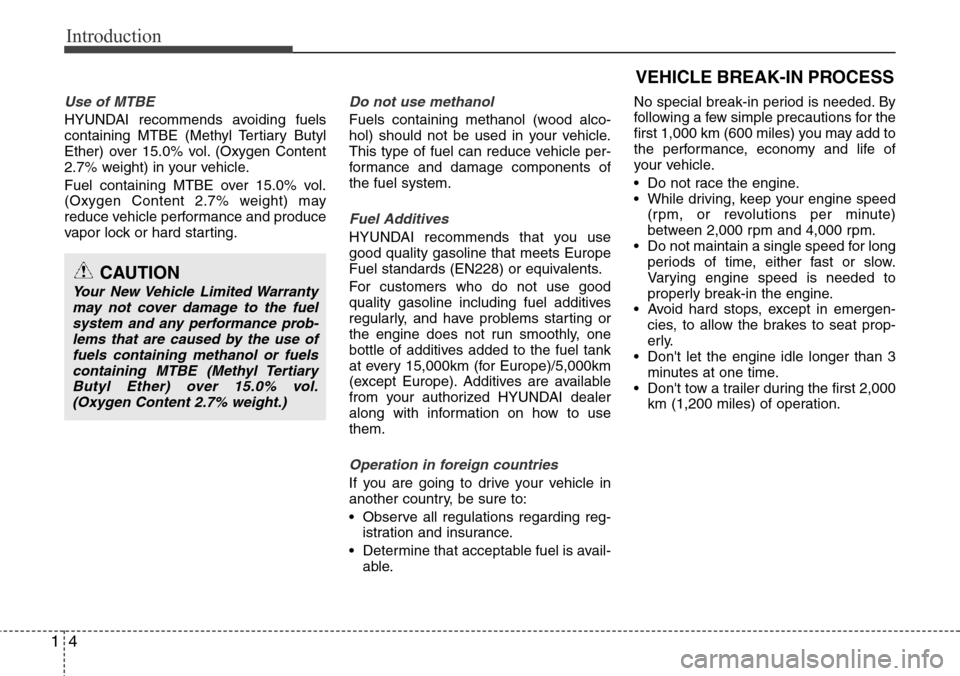
Introduction
4 1
Use of MTBE
HYUNDAI recommends avoiding fuels
containing MTBE (Methyl Tertiary Butyl
Ether) over 15.0% vol. (Oxygen Content
2.7% weight) in your vehicle.
Fuel containing MTBE over 15.0% vol.
(Oxygen Content 2.7% weight) may
reduce vehicle performance and produce
vapor lock or hard starting.
Do not use methanol
Fuels containing methanol (wood alco-
hol) should not be used in your vehicle.
This type of fuel can reduce vehicle per-
formance and damage components of
the fuel system.
Fuel Additives
HYUNDAI recommends that you use
good quality gasoline that meets Europe
Fuel standards (EN228) or equivalents.
For customers who do not use good
quality gasoline including fuel additives
regularly, and have problems starting or
the engine does not run smoothly, one
bottle of additives added to the fuel tank
at every 15,000km (for Europe)/5,000km
(except Europe). Additives are available
from your authorized HYUNDAI dealer
along with information on how to use
them.
Operation in foreign countries
If you are going to drive your vehicle in
another country, be sure to:
• Observe all regulations regarding reg-
istration and insurance.
• Determine that acceptable fuel is avail-
able.No special break-in period is needed. By
following a few simple precautions for the
first 1,000 km (600 miles) you may add to
the performance, economy and life of
your vehicle.
• Do not race the engine.
• While driving, keep your engine speed
(rpm, or revolutions per minute)
between 2,000 rpm and 4,000 rpm.
• Do not maintain a single speed for long
periods of time, either fast or slow.
Varying engine speed is needed to
properly break-in the engine.
• Avoid hard stops, except in emergen-
cies, to allow the brakes to seat prop-
erly.
• Don't let the engine idle longer than 3
minutes at one time.
• Don't tow a trailer during the first 2,000
km (1,200 miles) of operation.
VEHICLE BREAK-IN PROCESS
CAUTION
Your New Vehicle Limited Warranty
may not cover damage to the fuel
system and any performance prob-
lems that are caused by the use of
fuels containing methanol or fuels
containing MTBE (Methyl Tertiary
Butyl Ether) over 15.0% vol.
(Oxygen Content 2.7% weight.)
Page 16 of 385
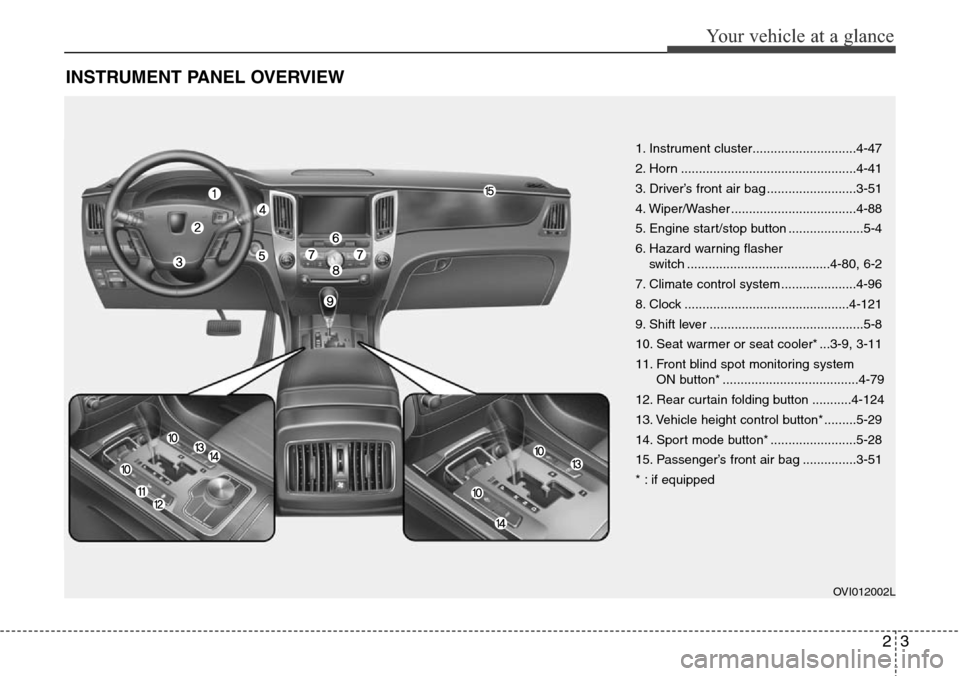
23
Your vehicle at a glance
INSTRUMENT PANEL OVERVIEW
1. Instrument cluster.............................4-47
2. Horn .................................................4-41
3. Driver’s front air bag .........................3-51
4. Wiper/Washer ...................................4-88
5. Engine start/stop button .....................5-4
6. Hazard warning flasher
switch ........................................4-80, 6-2
7. Climate control system .....................4-96
8. Clock ..............................................4-121
9. Shift lever ...........................................5-8
10. Seat warmer or seat cooler* ...3-9, 3-11
11. Front blind spot monitoring system
ON button* ......................................4-79
12. Rear curtain folding button ...........4-124
13. Vehicle height control button* .........5-29
14. Sport mode button* ........................5-28
15. Passenger’s front air bag ...............3-51
* : if equipped
OVI012002L
Page 23 of 385
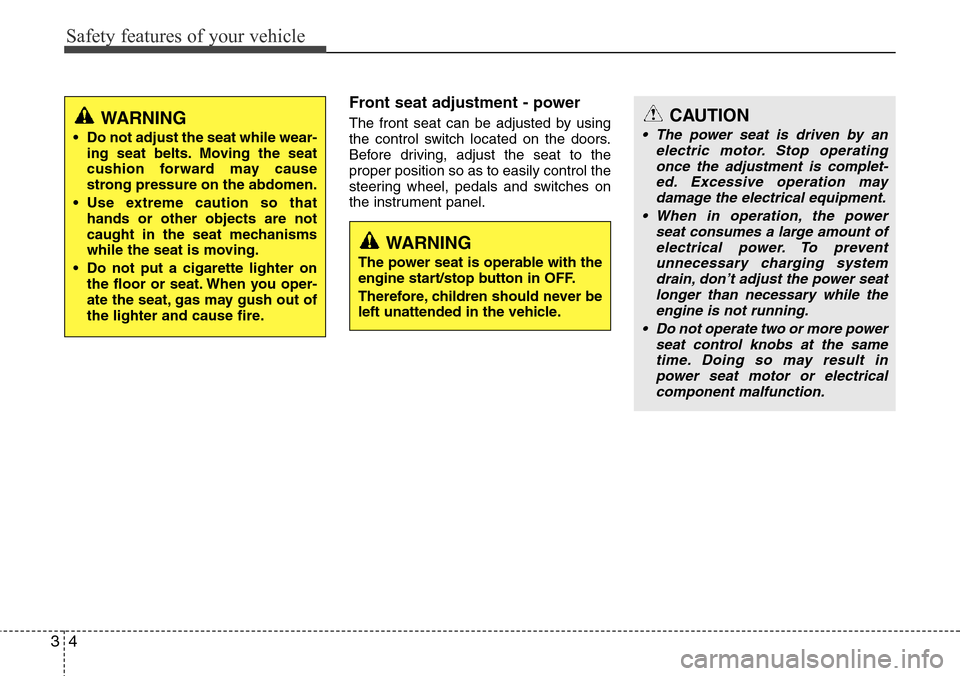
Safety features of your vehicle
4 3
Front seat adjustment - power
The front seat can be adjusted by using
the control switch located on the doors.
Before driving, adjust the seat to the
proper position so as to easily control the
steering wheel, pedals and switches on
the instrument panel.CAUTION
• The power seat is driven by an
electric motor. Stop operating
once the adjustment is complet-
ed. Excessive operation may
damage the electrical equipment.
• When in operation, the power
seat consumes a large amount of
electrical power. To prevent
unnecessary charging system
drain, don’t adjust the power seat
longer than necessary while the
engine is not running.
• Do not operate two or more power
seat control knobs at the same
time. Doing so may result in
power seat motor or electrical
component malfunction.
WARNING
The power seat is operable with the
engine start/stop button in OFF.
Therefore, children should never be
left unattended in the vehicle.
WARNING
• Do not adjust the seat while wear-
ing seat belts. Moving the seat
cushion forward may cause
strong pressure on the abdomen.
• Use extreme caution so that
hands or other objects are not
caught in the seat mechanisms
while the seat is moving.
• Do not put a cigarette lighter on
the floor or seat. When you oper-
ate the seat, gas may gush out of
the lighter and cause fire.
Page 29 of 385
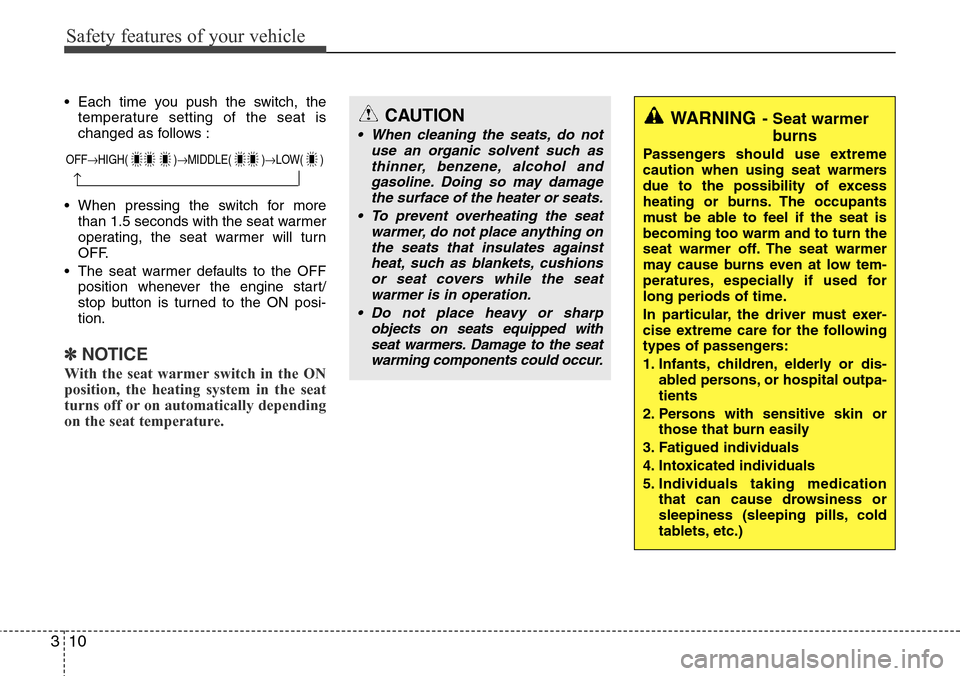
Safety features of your vehicle
10 3
• Each time you push the switch, the
temperature setting of the seat is
changed as follows :
• When pressing the switch for more
than 1.5 seconds with the seat warmer
operating, the seat warmer will turn
OFF.
• The seat warmer defaults to the OFF
position whenever the engine start/
stop button is turned to the ON posi-
tion.
✽NOTICE
With the seat warmer switch in the ON
position, the heating system in the seat
turns off or on automatically depending
on the seat temperature.
OFF→HIGH( )→MIDDLE( )→LOW( )
→
CAUTION
• When cleaning the seats, do not
use an organic solvent such as
thinner, benzene, alcohol and
gasoline. Doing so may damage
the surface of the heater or seats.
• To prevent overheating the seat
warmer, do not place anything on
the seats that insulates against
heat, such as blankets, cushions
or seat covers while the seat
warmer is in operation.
• Do not place heavy or sharp
objects on seats equipped with
seat warmers. Damage to the seat
warming components could occur.WARNING- Seat warmer
burns
Passengers should use extreme
caution when using seat warmers
due to the possibility of excess
heating or burns. The occupants
must be able to feel if the seat is
becoming too warm and to turn the
seat warmer off. The seat warmer
may cause burns even at low tem-
peratures, especially if used for
long periods of time.
In particular, the driver must exer-
cise extreme care for the following
types of passengers:
1. Infants, children, elderly or dis-
abled persons, or hospital outpa-
tients
2. Persons with sensitive skin or
those that burn easily
3. Fatigued individuals
4. Intoxicated individuals
5. Individuals taking medication
that can cause drowsiness or
sleepiness (sleeping pills, cold
tablets, etc.)
Page 30 of 385
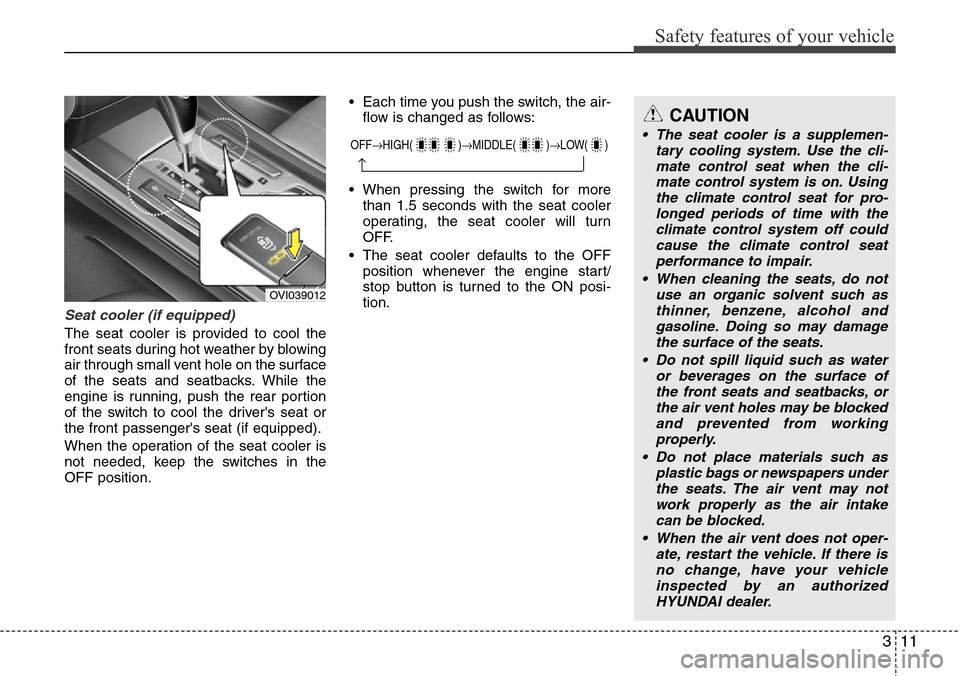
311
Safety features of your vehicle
Seat cooler (if equipped)
The seat cooler is provided to cool the
front seats during hot weather by blowing
air through small vent hole on the surface
of the seats and seatbacks. While the
engine is running, push the rear portion
of the switch to cool the driver's seat or
the front passenger's seat (if equipped).
When the operation of the seat cooler is
not needed, keep the switches in the
OFF position.• Each time you push the switch, the air-
flow is changed as follows:
• When pressing the switch for more
than 1.5 seconds with the seat cooler
operating, the seat cooler will turn
OFF.
• The seat cooler defaults to the OFF
position whenever the engine start/
stop button is turned to the ON posi-
tion.
OVI039012
OFF→HIGH( )→MIDDLE( )→LOW( )
→
CAUTION
• The seat cooler is a supplemen-
tary cooling system. Use the cli-
mate control seat when the cli-
mate control system is on. Using
the climate control seat for pro-
longed periods of time with the
climate control system off could
cause the climate control seat
performance to impair.
• When cleaning the seats, do not
use an organic solvent such as
thinner, benzene, alcohol and
gasoline. Doing so may damage
the surface of the seats.
• Do not spill liquid such as water
or beverages on the surface of
the front seats and seatbacks, or
the air vent holes may be blocked
and prevented from working
properly.
• Do not place materials such as
plastic bags or newspapers under
the seats. The air vent may not
work properly as the air intake
can be blocked.
• When the air vent does not oper-
ate, restart the vehicle. If there is
no change, have your vehicle
inspected by an authorized
HYUNDAI dealer.
Page 32 of 385
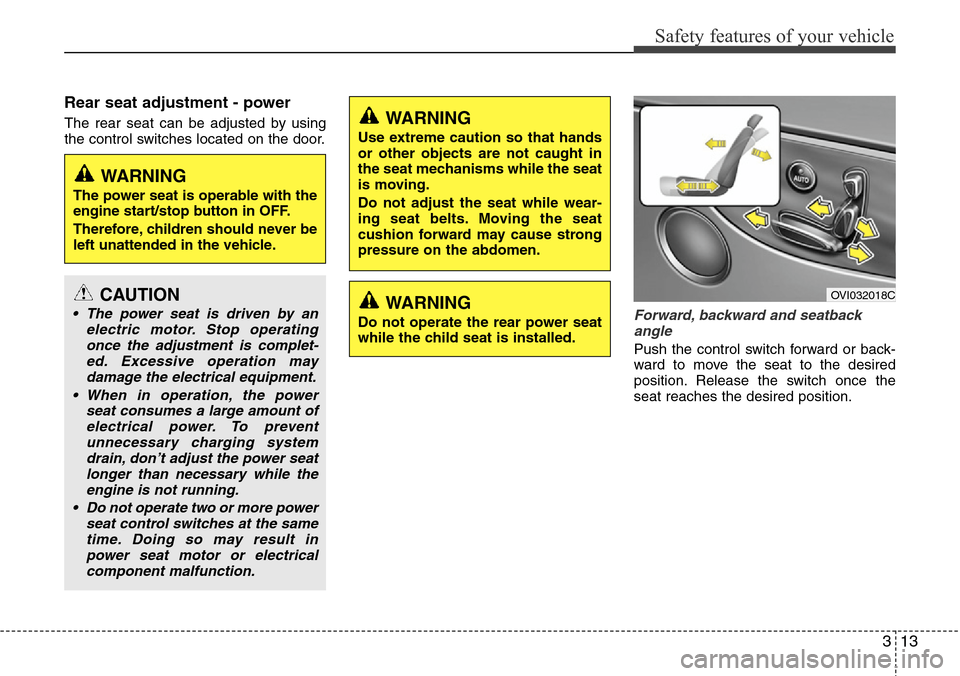
313
Safety features of your vehicle
Rear seat adjustment - power
The rear seat can be adjusted by using
the control switches located on the door.
Forward, backward and seatback
angle
Push the control switch forward or back-
ward to move the seat to the desired
position. Release the switch once the
seat reaches the desired position.
WARNING
The power seat is operable with the
engine start/stop button in OFF.
Therefore, children should never be
left unattended in the vehicle.
CAUTION
• The power seat is driven by an
electric motor. Stop operating
once the adjustment is complet-
ed. Excessive operation may
damage the electrical equipment.
• When in operation, the power
seat consumes a large amount of
electrical power. To prevent
unnecessary charging system
drain, don’t adjust the power seat
longer than necessary while the
engine is not running.
• Do not operate two or more power
seat control switches at the same
time. Doing so may result in
power seat motor or electrical
component malfunction.
WARNING
Use extreme caution so that hands
or other objects are not caught in
the seat mechanisms while the seat
is moving.
Do not adjust the seat while wear-
ing seat belts. Moving the seat
cushion forward may cause strong
pressure on the abdomen.
WARNING
Do not operate the rear power seat
while the child seat is installed.
OVI032018C
Page 42 of 385
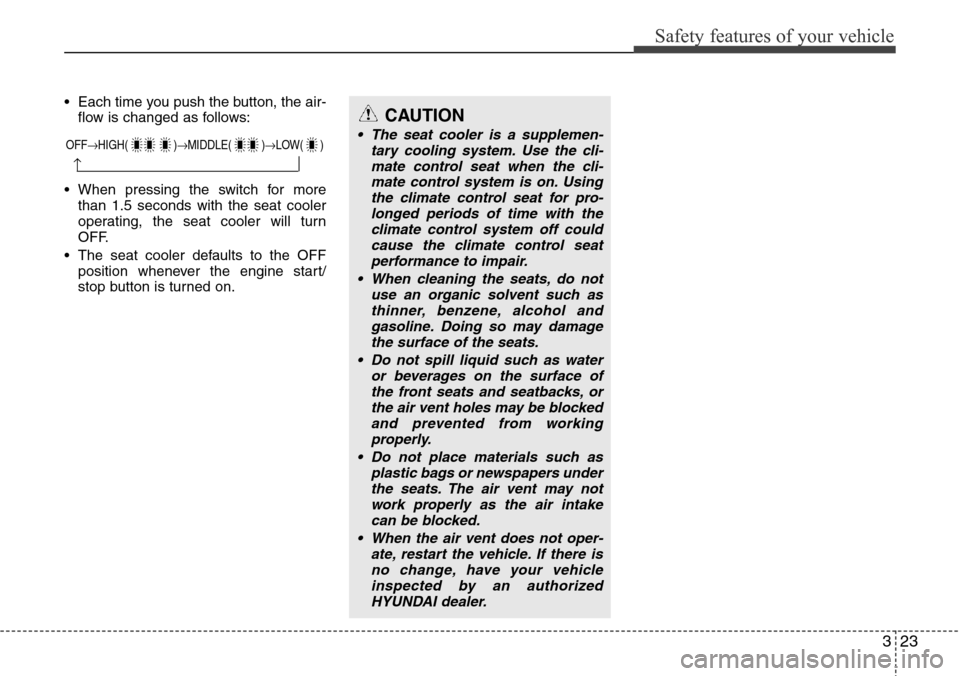
323
Safety features of your vehicle
• Each time you push the button, the air-
flow is changed as follows:
• When pressing the switch for more
than 1.5 seconds with the seat cooler
operating, the seat cooler will turn
OFF.
• The seat cooler defaults to the OFF
position whenever the engine start/
stop button is turned on.
OFF→HIGH( )→MIDDLE( )→LOW( )
→
CAUTION
• The seat cooler is a supplemen-
tary cooling system. Use the cli-
mate control seat when the cli-
mate control system is on. Using
the climate control seat for pro-
longed periods of time with the
climate control system off could
cause the climate control seat
performance to impair.
• When cleaning the seats, do not
use an organic solvent such as
thinner, benzene, alcohol and
gasoline. Doing so may damage
the surface of the seats.
• Do not spill liquid such as water
or beverages on the surface of
the front seats and seatbacks, or
the air vent holes may be blocked
and prevented from working
properly.
• Do not place materials such as
plastic bags or newspapers under
the seats. The air vent may not
work properly as the air intake
can be blocked.
• When the air vent does not oper-
ate, restart the vehicle. If there is
no change, have your vehicle
inspected by an authorized
HYUNDAI dealer.
Page 44 of 385
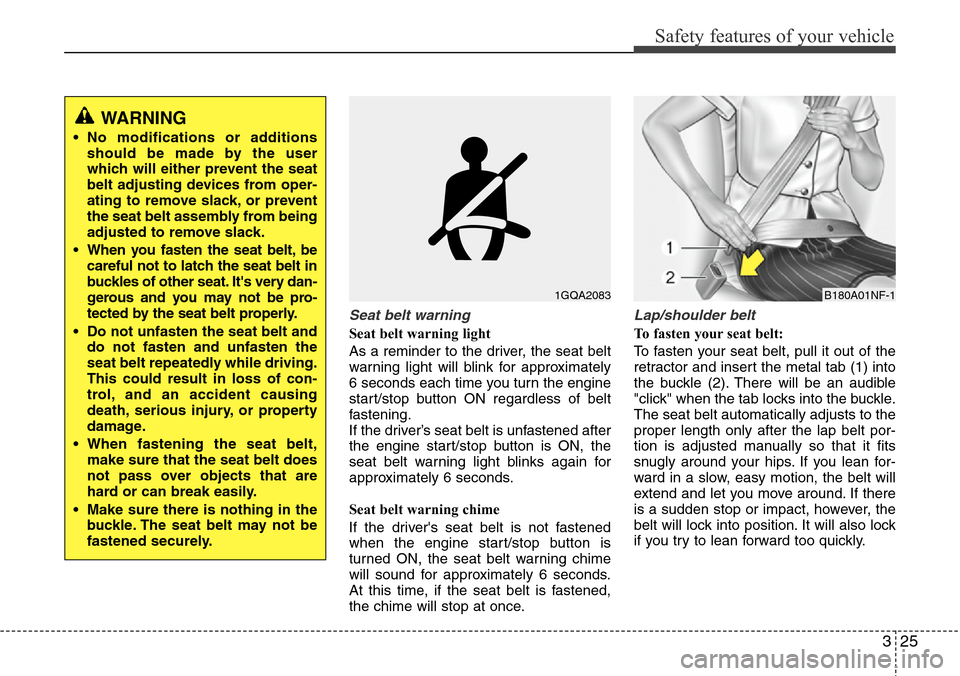
325
Safety features of your vehicle
Seat belt warning
Seat belt warning light
As a reminder to the driver, the seat belt
warning light will blink for approximately
6 seconds each time you turn the engine
start/stop button ON regardless of belt
fastening.
If the driver’s seat belt is unfastened after
the engine start/stop button is ON, the
seat belt warning light blinks again for
approximately 6 seconds.
Seat belt warning chime
If the driver's seat belt is not fastened
when the engine start/stop button is
turned ON, the seat belt warning chime
will sound for approximately 6 seconds.
At this time, if the seat belt is fastened,
the chime will stop at once.
Lap/shoulder belt
To fasten your seat belt:
To fasten your seat belt, pull it out of the
retractor and insert the metal tab (1) into
the buckle (2). There will be an audible
"click" when the tab locks into the buckle.
The seat belt automatically adjusts to the
proper length only after the lap belt por-
tion is adjusted manually so that it fits
snugly around your hips. If you lean for-
ward in a slow, easy motion, the belt will
extend and let you move around. If there
is a sudden stop or impact, however, the
belt will lock into position. It will also lock
if you try to lean forward too quickly.
1GQA2083B180A01NF-1
WARNING
• No modifications or additions
should be made by the user
which will either prevent the seat
belt adjusting devices from oper-
ating to remove slack, or prevent
the seat belt assembly from being
adjusted to remove slack.
• When you fasten the seat belt, be
careful not to latch the seat belt in
buckles of other seat. It's very dan-
gerous and you may not be pro-
tected by the seat belt properly.
• Do not unfasten the seat belt and
do not fasten and unfasten the
seat belt repeatedly while driving.
This could result in loss of con-
trol, and an accident causing
death, serious injury, or property
damage.
• When fastening the seat belt,
make sure that the seat belt does
not pass over objects that are
hard or can break easily.
• Make sure there is nothing in the
buckle. The seat belt may not be
fastened securely.
Page 51 of 385
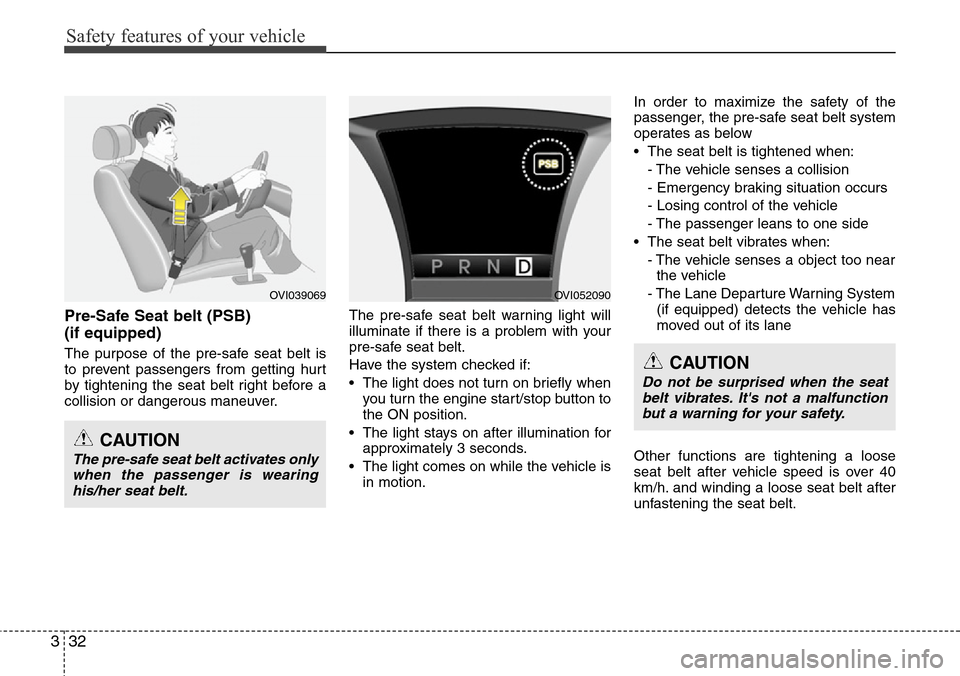
Safety features of your vehicle
32 3
Pre-Safe Seat belt (PSB)
(if equipped)
The purpose of the pre-safe seat belt is
to prevent passengers from getting hurt
by tightening the seat belt right before a
collision or dangerous maneuver.The pre-safe seat belt warning light will
illuminate if there is a problem with your
pre-safe seat belt.
Have the system checked if:
• The light does not turn on briefly when
you turn the engine start/stop button to
the ON position.
• The light stays on after illumination for
approximately 3 seconds.
• The light comes on while the vehicle is
in motion.In order to maximize the safety of the
passenger, the pre-safe seat belt system
operates as below
• The seat belt is tightened when:
- The vehicle senses a collision
- Emergency braking situation occurs
- Losing control of the vehicle
- The passenger leans to one side
• The seat belt vibrates when:
- The vehicle senses a object too near
the vehicle
- The Lane Departure Warning System
(if equipped) detects the vehicle has
moved out of its lane
Other functions are tightening a loose
seat belt after vehicle speed is over 40
km/h. and winding a loose seat belt after
unfastening the seat belt.
OVI039069OVI052090
CAUTION
The pre-safe seat belt activates only
when the passenger is wearing
his/her seat belt.
CAUTION
Do not be surprised when the seat
belt vibrates. It's not a malfunction
but a warning for your safety.
Page 65 of 385
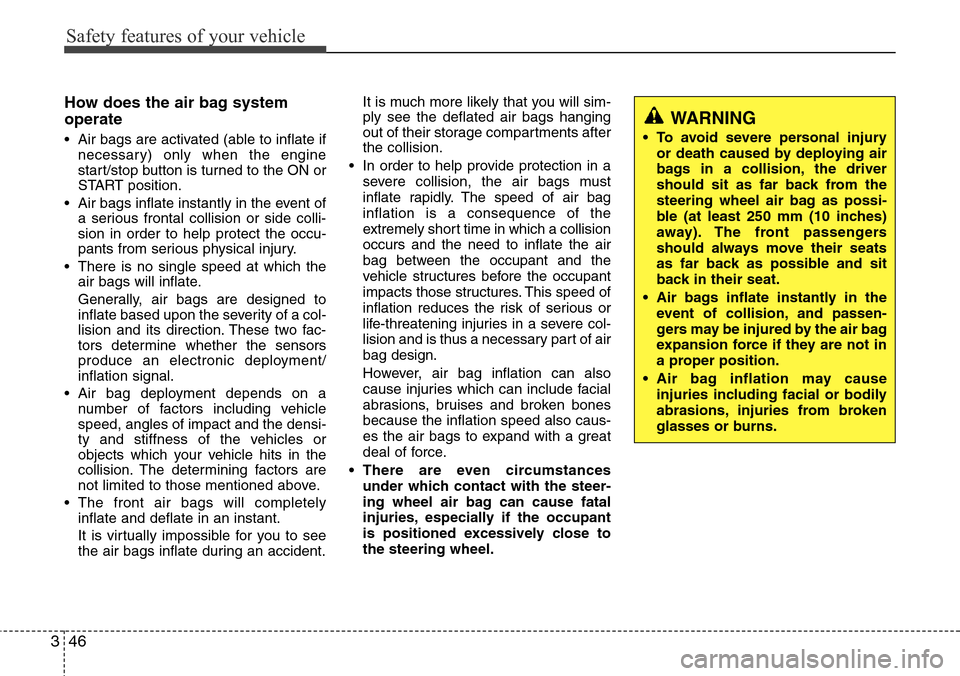
Safety features of your vehicle
46 3
How does the air bag system
operate
• Air bags are activated (able to inflate if
necessary) only when the engine
start/stop button is turned to the ON or
START position.
• Air bags inflate instantly in the event of
a serious frontal collision or side colli-
sion in order to help protect the occu-
pants from serious physical injury.
• There is no single speed at which the
air bags will inflate.
Generally, air bags are designed to
inflate based upon the severity of a col-
lision and its direction. These two fac-
tors determine whether the sensors
produce an electronic deployment/
inflation signal.
• Air bag deployment depends on a
number of factors including vehicle
speed, angles of impact and the densi-
ty and stiffness of the vehicles or
objects which your vehicle hits in the
collision. The determining factors are
not limited to those mentioned above.
• The front air bags will completely
inflate and deflate in an instant.
It is virtually impossible for you to see
the air bags inflate during an accident.It is much more likely that you will sim-
ply see the deflated air bags hanging
out of their storage compartments after
the collision.
• In order to help provide protection in a
severe collision, the air bags must
inflate rapidly. The speed of air bag
inflation is a consequence of the
extremely short time in which a collision
occurs and the need to inflate the air
bag between the occupant and the
vehicle structures before the occupant
impacts those structures. This speed of
inflation reduces the risk of serious or
life-threatening injuries in a severe col-
lision and is thus a necessary part of air
bag design.
However, air bag inflation can also
cause injuries which can include facial
abrasions, bruises and broken bones
because the inflation speed also caus-
es the air bags to expand with a great
deal of force.
• There are even circumstances
under which contact with the steer-
ing wheel air bag can cause fatal
injuries, especially if the occupant
is positioned excessively close to
the steering wheel.
WARNING
• To avoid severe personal injury
or death caused by deploying air
bags in a collision, the driver
should sit as far back from the
steering wheel air bag as possi-
ble (at least 250 mm (10 inches)
away). The front passengers
should always move their seats
as far back as possible and sit
back in their seat.
• Air bags inflate instantly in the
event of collision, and passen-
gers may be injured by the air bag
expansion force if they are not in
a proper position.
• Air bag inflation may cause
injuries including facial or bodily
abrasions, injuries from broken
glasses or burns.